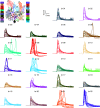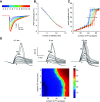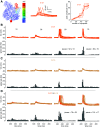The Cellular Electrophysiological Properties Underlying Multiplexed Coding in Purkinje Cells
- PMID: 33452223
- PMCID: PMC7939085
- DOI: 10.1523/JNEUROSCI.1719-20.2020
The Cellular Electrophysiological Properties Underlying Multiplexed Coding in Purkinje Cells
Abstract
Neuronal firing patterns are crucial to underpin circuit level behaviors. In cerebellar Purkinje cells (PCs), both spike rates and pauses are used for behavioral coding, but the cellular mechanisms causing code transitions remain unknown. We use a well-validated PC model to explore the coding strategy that individual PCs use to process parallel fiber (PF) inputs. We find increasing input intensity shifts PCs from linear rate-coders to burst-pause timing-coders by triggering localized dendritic spikes. We validate dendritic spike properties with experimental data, elucidate spiking mechanisms, and predict spiking thresholds with and without inhibition. Both linear and burst-pause computations use individual branches as computational units, which challenges the traditional view of PCs as linear point neurons. Dendritic spike thresholds can be regulated by voltage state, compartmentalized channel modulation, between-branch interaction and synaptic inhibition to expand the dynamic range of linear computation or burst-pause computation. In addition, co-activated PF inputs between branches can modify somatic maximum spike rates and pause durations to make them carry analog signals. Our results provide new insights into the strategies used by individual neurons to expand their capacity of information processing.SIGNIFICANCE STATEMENT Understanding how neurons process information is a fundamental question in neuroscience. Purkinje cells (PCs) were traditionally regarded as linear point neurons. We used computational modeling to unveil their electrophysiological properties underlying the multiplexed coding strategy that is observed during behaviors. We demonstrate that increasing input intensity triggers localized dendritic spikes, shifting PCs from linear rate-coders to burst-pause timing-coders. Both coding strategies work at the level of individual dendritic branches. Our work suggests that PCs have the ability to implement branch-specific multiplexed coding at the cellular level, thereby increasing the capacity of cerebellar coding and learning.
Keywords: Purkinje cell; burst-pause computation; cerebellum; dendritic spikes; linear computation; multiplexed coding.
Copyright © 2021 Zang and De Schutter.
Figures











Similar articles
-
Modulation of the dynamics of cerebellar Purkinje cells through the interaction of excitatory and inhibitory feedforward pathways.PLoS Comput Biol. 2021 Feb 10;17(2):e1008670. doi: 10.1371/journal.pcbi.1008670. eCollection 2021 Feb. PLoS Comput Biol. 2021. PMID: 33566820 Free PMC article.
-
Multiplexed coding by cerebellar Purkinje neurons.Elife. 2016 Jul 26;5:e13810. doi: 10.7554/eLife.13810. Elife. 2016. PMID: 27458803 Free PMC article.
-
The origin of the complex spike in cerebellar Purkinje cells.J Neurosci. 2008 Jul 23;28(30):7599-609. doi: 10.1523/JNEUROSCI.0559-08.2008. J Neurosci. 2008. PMID: 18650337 Free PMC article.
-
Patterns and pauses in Purkinje cell simple spike trains: experiments, modeling and theory.Neuroscience. 2009 Sep 1;162(3):816-26. doi: 10.1016/j.neuroscience.2009.02.040. Epub 2009 Feb 26. Neuroscience. 2009. PMID: 19249335 Review.
-
Using realistic models to study synaptic integration in cerebellar Purkinje cells.Rev Neurosci. 1999;10(3-4):233-45. doi: 10.1515/revneuro.1999.10.3-4.233. Rev Neurosci. 1999. PMID: 10526889 Review.
Cited by
-
Cerebellar contributions to dystonia: unraveling the role of Purkinje cells and cerebellar nuclei.Dystonia. 2025;4:14006. doi: 10.3389/dyst.2025.14006. Epub 2025 Feb 16. Dystonia. 2025. PMID: 40115904 Free PMC article.
-
Basket to Purkinje Cell Inhibitory Ephaptic Coupling Is Abolished in Episodic Ataxia Type 1.Cells. 2023 May 13;12(10):1382. doi: 10.3390/cells12101382. Cells. 2023. PMID: 37408217 Free PMC article.
-
Purkinje cell models: past, present and future.Front Comput Neurosci. 2024 Jul 10;18:1426653. doi: 10.3389/fncom.2024.1426653. eCollection 2024. Front Comput Neurosci. 2024. PMID: 39049990 Free PMC article. Review.
-
Discrimination and learning of temporal input sequences in a cerebellar Purkinje cell model.Front Cell Neurosci. 2023 Feb 2;17:1075005. doi: 10.3389/fncel.2023.1075005. eCollection 2023. Front Cell Neurosci. 2023. PMID: 36816857 Free PMC article.
-
Biologically-Based Computation: How Neural Details and Dynamics Are Suited for Implementing a Variety of Algorithms.Brain Sci. 2023 Jan 31;13(2):245. doi: 10.3390/brainsci13020245. Brain Sci. 2023. PMID: 36831788 Free PMC article.
References
Publication types
MeSH terms
Grants and funding
LinkOut - more resources
Full Text Sources
Other Literature Sources
Molecular Biology Databases
